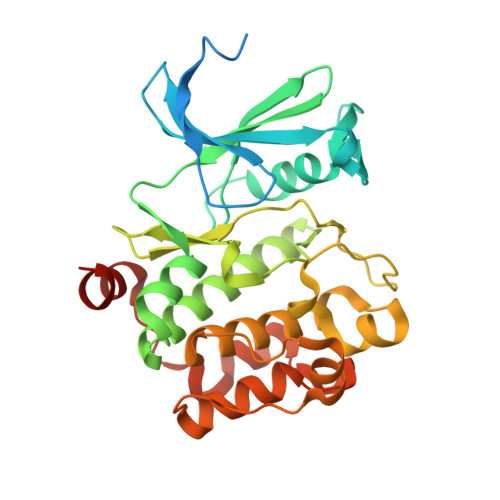Cell-permeable carboxyl-terminal p27(Kip1) peptide exhibits anti-tumor activity by inhibiting Pim-1 kinase
Morishita, D., Takami, M., Yoshikawa, S., Katayama, R., Sato, S., Kukimoto-Niino, M., Umehara, T., Shirouzu, M., Sekimizu, K., Yokoyama, S., Fujita, N.(2011) J Biol Chem 286: 2681-2688
- PubMed: 21062737
- DOI: https://doi.org/10.1074/jbc.M109.092452
- Primary Citation of Related Structures:
3A99 - PubMed Abstract:
The incidence and death rate of prostate cancer is increasing rapidly. In addition, the low sensitivity of prostate cancer to chemotherapy makes it difficult to treat this condition. The serine/threonine kinase Pim-1 plays an important role in cell cycle progression and apoptosis inhibition, resulting in prostate tumorigenesis. Therefore, Pim-1 inhibition has been expected to be an attractive target for developing new anti-cancer drugs. However, no small compounds targeting Pim-1 have progressed to clinical use because of their lack of specificity. Here, we have reported a new cell-permeable Pim-1 inhibitory p27(Kip1) peptide that could interfere with the binding of Pim-1 to its substrates and act as an anti-cancer drug. The peptide could bind to Pim-1 and inhibit phosphorylation of endogenous p27(Kip1) and Bad by Pim-1. Treatment of prostate cancer with the peptide induces G(1) arrest and subsequently apoptosis in vitro. However, the peptide showed almost no growth inhibitory or apoptosis-inducing effects in normal cells. The peptide could inhibit tumor growth in in vivo prostate cancer xenograft models. Moreover, the peptide treatment could overcome resistance to taxol, one of the first line chemotherapeutic agents for prostate cancer, and a combination of the peptide with taxol synergistically inhibited prostate cancer growth in vivo. These results indicate that a Pim-1 inhibitory p27(Kip1) peptide could be developed as an anti-cancer drug against prostate cancer.
Organizational Affiliation:
Cancer Chemotherapy Center, Japanese Foundation for Cancer Research, Tokyo 135-8550, Japan.
















